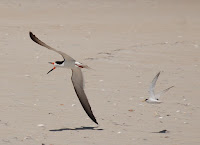BLACK SKIMMER
BLACK SKIMMER – (Rynchops niger) – (See images below)
DESCRIPTION: The Black Skimmer in breeding plumage has a black head, nape and upper parts. Tern-like wings are slim and long. Forehead, face, throat and under parts are white. Bill is red near the base, dark grey for remainder part. Lower mandible is about 25% longer than the upper one. Eyes are black, legs are red. In winter plumage adults have a washed out black cap and a white nape. Juveniles are mottled brown on top, with a brown bill and yellowish legs. Sexes are similar. Bird length is about 41 cm (16 inches). There are three subspecies.
VOICE: https://www.xeno-canto.org/species/Rynchops-niger
NAME: English name was given to this bird by Thomas Pennant in 1773. ‘Skimmer’ refers to bird’s feeding behavior (see Diet below). Latin genus name ‘Rynchops’ means ‘beak’ and ‘face’ (Greek). Latin species name ‘niger’ means ‘black’.
HABITAT: Coastal waters, also along large rivers in winter.
DIET: Fish for the most part, also some crustaceans. Feeds by immersing its lower bill in the water, and ‘skimming’ over it.
NESTING: Nests in colonies on the ground (sand islands, sandbars). From three to five eggs of varying colors (beige, green-blue) are laid, incubated by both parents, who also both feed the chicks.
DISTRIBUTION: Breeding range includes along the coast of middle eastern USA and northern half of Chile; year-round resident along the coasts of southeast USA and South America (except the Andes region). There are also non-breeding populations along the coasts of Mexico and Central America.
Distribution Map: https://en.wikipedia.org/wiki/Black_skimmer – /media/File:Rynchops_niger_map.svg
ON PEI: Does not breed on Prince Edward Island, sightings listed as ‘accidental’ so far. See note below on bird vagrancy.
CONSERVATION: Used to be hunted for its feathers and egg harvesting, population in serious decline. A major threat is loss of breeding habitat (sandy beaches) to development. Still evaluated as ‘least concern’.
Vagrancy: In biology this means an animal going way outside its normal range. For birds, this can happen when there are storms and they get blown off course. On other times, the bird simply wanders in a different direction than usual. Here’s an article about vagrancy in birds.
SIMILAR SPECIES: Caspian tern, Royal tern, Common tern
REFERENCES: https://guides.nynhp.org/black-skimmer/ (New York Natural Heritage Program)
https://animaldiversity.org/accounts/Rynchops_niger/ (University of Michigan)
https://www.audubon.org/field-guide/bird/black-skimmer
American Bird Conservancy (Black Skimmer)
https://txtbba.tamu.edu/species-accounts/black-skimmer/ (Texas Breeding Bird Atlas)
https://www.allaboutbirds.org/guide/Black_Skimmer/lifehistory
https://en.wikipedia.org/wiki/Black_skimmer
http://identify.whatbird.com/obj/452/overview/Black_Skimmer.aspx
DESCRIPTION: The Black Skimmer in breeding plumage has a black head, nape and upper parts. Tern-like wings are slim and long. Forehead, face, throat and under parts are white. Bill is red near the base, dark grey for remainder part. Lower mandible is about 25% longer than the upper one. Eyes are black, legs are red. In winter plumage adults have a washed out black cap and a white nape. Juveniles are mottled brown on top, with a brown bill and yellowish legs. Sexes are similar. Bird length is about 41 cm (16 inches). There are three subspecies.
VOICE: https://www.xeno-canto.org/species/Rynchops-niger
NAME: English name was given to this bird by Thomas Pennant in 1773. ‘Skimmer’ refers to bird’s feeding behavior (see Diet below). Latin genus name ‘Rynchops’ means ‘beak’ and ‘face’ (Greek). Latin species name ‘niger’ means ‘black’.
HABITAT: Coastal waters, also along large rivers in winter.
DIET: Fish for the most part, also some crustaceans. Feeds by immersing its lower bill in the water, and ‘skimming’ over it.
NESTING: Nests in colonies on the ground (sand islands, sandbars). From three to five eggs of varying colors (beige, green-blue) are laid, incubated by both parents, who also both feed the chicks.
DISTRIBUTION: Breeding range includes along the coast of middle eastern USA and northern half of Chile; year-round resident along the coasts of southeast USA and South America (except the Andes region). There are also non-breeding populations along the coasts of Mexico and Central America.
Distribution Map: https://en.wikipedia.org/wiki/Black_skimmer – /media/File:Rynchops_niger_map.svg
ON PEI: Does not breed on Prince Edward Island, sightings listed as ‘accidental’ so far. See note below on bird vagrancy.
CONSERVATION: Used to be hunted for its feathers and egg harvesting, population in serious decline. A major threat is loss of breeding habitat (sandy beaches) to development. Still evaluated as ‘least concern’.
Vagrancy: In biology this means an animal going way outside its normal range. For birds, this can happen when there are storms and they get blown off course. On other times, the bird simply wanders in a different direction than usual. Here’s an article about vagrancy in birds.
SIMILAR SPECIES: Caspian tern, Royal tern, Common tern
REFERENCES: https://guides.nynhp.org/black-skimmer/ (New York Natural Heritage Program)
https://animaldiversity.org/accounts/Rynchops_niger/ (University of Michigan)
https://www.audubon.org/field-guide/bird/black-skimmer
American Bird Conservancy (Black Skimmer)
https://txtbba.tamu.edu/species-accounts/black-skimmer/ (Texas Breeding Bird Atlas)
https://www.allaboutbirds.org/guide/Black_Skimmer/lifehistory
https://en.wikipedia.org/wiki/Black_skimmer
http://identify.whatbird.com/obj/452/overview/Black_Skimmer.aspx
 |
| Black skimmer, Brasil, by Andreas Trepte |
 |
| Black skimmer chased by Least tern NC, by Jarek Tuszynski |
 |
| Black skimmer feeding, Dan Pancamo |
 |
| Black skimmer juveniles at 4 weeks TX, by Dan Pancamo |
 |
| Black skimmer parent feeding a chick, TX, by Dan Pancamo |
 |
| Black skimmer, winter plumage, by Googie Man |
 |
| Black skimmers in flight, by Terry Foote |